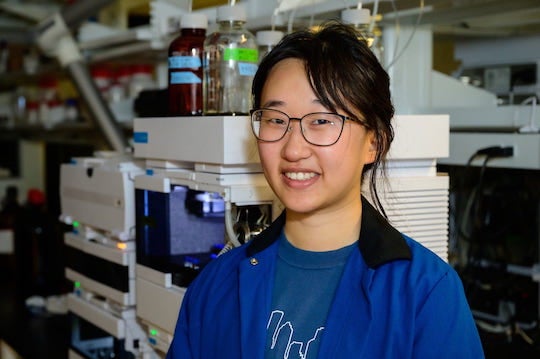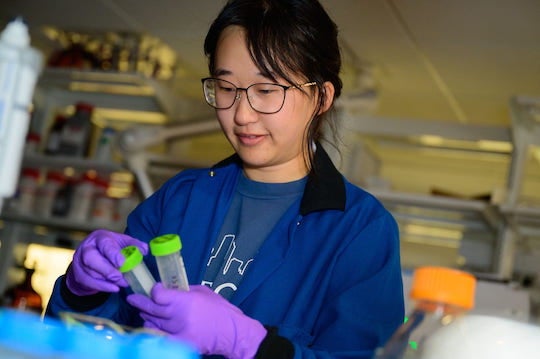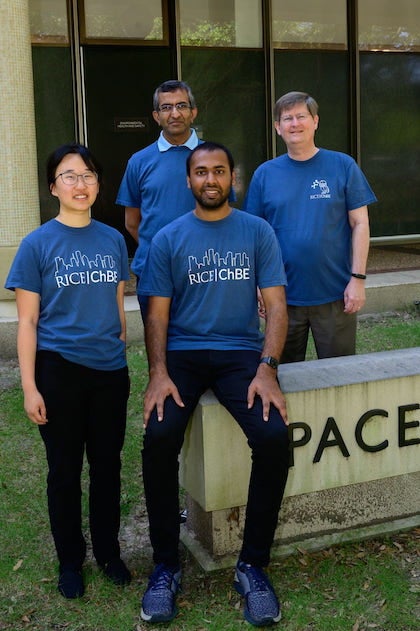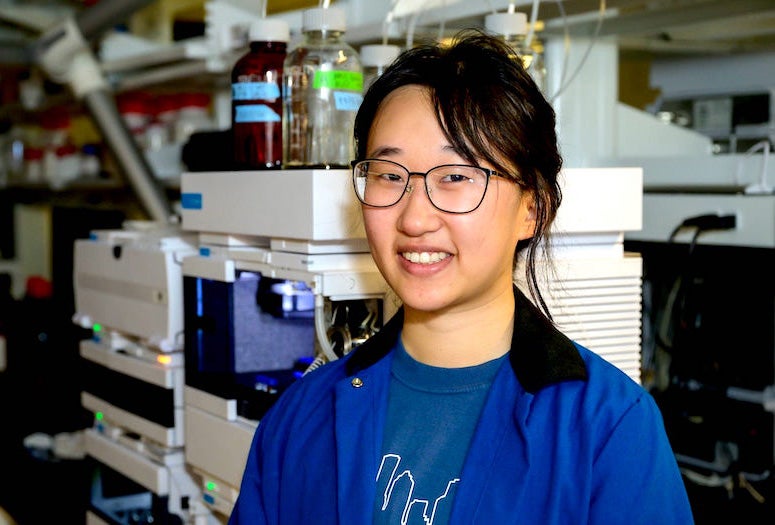Winnie Shi, a Rice University chemical and biomolecular engineering graduate student, has been selected to participate in the Office of Science Graduate Student Research (SCGSR) Program at the U.S. Department of Energy (DOE).

The goal of the program is to prepare graduate students for science, technology, engineering or mathematics (STEM) careers critically important to the DOE Office of Science mission by providing graduate thesis research opportunities through extended residency at DOE national laboratories. In addition to access to research facilities and mentorship from a designated DOE scientist sponsor, awardees also receive travel support and a monthly stipend.
Shi will spend time at the Oak Ridge National Laboratory using its Spallation Neutron Source facilities to investigate how polyampholytes ⎯ a class of polymers that contain both positively and negatively charged groups ⎯ change in response to modifications to their sequence of charges.
Polyampholytes are used in a wide range of industrial settings such as medicine and biotechnology, nanotechnology and filtration systems. Their unique properties make them relevant to emerging technologies such as biosensor and energy storage applications.

“I was very excited when I got the award notice,” Shi said. “I feel really honored to take part in this program. It’s a great opportunity to take my samples and perform experiments that I would otherwise be unable to do. It’s also a great opportunity to learn from experts like my sponsor, Wei-Ren Chen, a DOE scientist who is a leading figure in polymer modeling and neutron scattering research.”
According to Amanda Marciel, an assistant professor of chemical and biomolecular engineering and William Marsh Rice Trustee Chair who is Shi’s adviser, the work “is a vital step towards the design of novel water-based materials and understanding the role of polyampholyte-like proteins in intracellular processes.”
“The SCGSR program is an amazing opportunity for (Shi) to use advanced neutron scattering techniques to study the conformation and dynamics of polyampholyte molecules,” she added.

Neutron scattering involves directing a beam of neutrons through a given material sample and recording the way in which the particles scatter upon collision. This data gives researchers clues about material properties and dynamics at the smallest scales.
Understanding polyampholytes is also critical for advancing our knowledge of how proteins fold, especially intrinsically disordered proteins.
“Like the name suggests, these proteins don’t have a rigid structure, or, rather, you can’t form any expectations about the structure they might take based on the sequence of their component parts,” Shi said. “In a sense, you could say this type of protein doesn’t fold at all ⎯ in layman’s terms, they’re like floating blobs of spaghetti.”
Rohan Adhikari, a Rice graduate student and one of Shi’s collaborators, pointed out that these proteins “are expected to play a key role in many cellular phenomena and even in some neurological disorders such as Huntington's or Alzheimer's disease.”

Shi said she hopes to “figure out what role the conformation of these peptides plays in the development of these diseases.”
According to Dilipkumar Asthagiri, a Rice adjunct professor of chemical and biomolecular engineering and a staff scientist at the Oak Ridge National Laboratory, Shi’s research is relevant to understanding intracellular liquid-liquid phase separation phenomena that occur when “different areas inside cells can have different concentrations of certain components.”
While growing evidence suggests these phenomena play a critical role in human health and disease development, studying them is a significant challenge for scientists due to the complexity of the intracellular environment.
“What Winnie does is make very clean peptides, very clean systems that allow us to study these phenomena better,” Asthagiri said.
Walter Chapman, Rice’s William W. Akers Chair Professor of Chemical and Biomolecular Engineering and the department’s director of undergraduate studies, added that Shi’s research “has broader impact because these systems are good models for understanding polyelectrolytes and copolymer systems for other applications and chemical processing.”
- Award information:
-
https://science.osti.gov/WDTS/SCGSR/SCGSR-Awards-and-Publications
- Image downloads:
-
https://news-network.rice.edu/news/files/2023/05/230519_WS_1LG.jpg
CAPTION: Winnie Shi is a Rice University chemical and biomolecular engineering graduate student and a recipient of this year’s Office of Science Graduate Student Research Program Award. (Photo by Jeff Fitlow/Rice University)https://news-network.rice.edu/news/files/2023/05/230519_WS_2LG.jpg
CAPTION: Winnie Shi will spend time at Oak Ridge National Laboratory using neutron scattering to study the conformation and dynamics of polyampholyte molecules. (Photo by Jeff Fitlow/Rice University)https://news-network.rice.edu/news/files/2023/05/230519_WS_3LG.jpg
CAPTION: Winnie Shi (clockwise from left), Dilipkumar Asthagiri, Walter Chapman and Rohan Adhikari. (Photo by Jeff Fitlow/Rice University)https://news-network.rice.edu/news/files/2023/05/Amanda_Marciel_LG.jpg
CAPTION: Amanda Marciel, an assistant professor of chemical and biomolecular engineering and William Marsh Rice Trustee Chair, is Shi’s adviser. (Photo courtesy of Amanda Marciel)
- About Rice:
-
Located on a 300-acre forested campus in Houston, Rice University is consistently ranked among the nation’s top 20 universities by U.S. News & World Report. Rice has highly respected schools of Architecture, Business, Continuing Studies, Engineering, Humanities, Music, Natural Sciences and Social Sciences and is home to the Baker Institute for Public Policy. With 4,552 undergraduates and 3,998 graduate students, Rice’s undergraduate student-to-faculty ratio is just under 6-to-1. Its residential college system builds close-knit communities and lifelong friendships, just one reason why Rice is ranked No. 1 for lots of race/class interaction and No. 4 for quality of life by the Princeton Review. Rice is also rated as a best value among private universities by Kiplinger’s Personal Finance.

